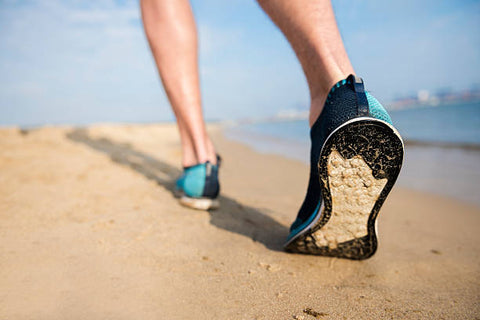Can Beach Walking Strengthen Feet & Combat Plantar Fasciitis?

by Dr. Emily Splichal, DPM MS
Nothing beats a walk on the beach! But what do you do if you have flat feet or are experiencing heel pain?
Is it still safe to walk in the sand?
And can it be used as a way to strengthen the feet?

Over-pronation, or the collapsing of the medial arch, is one of the most common contributors to plantar foot stress and plantar fasciitis.
The instability associated with a dropped arch can lead to soft tissue overload of impact forces, delayed transfer of energy, transfer stress into the knees and low back pain. In those diagnosed with plantar fasciitis and over-pronation, arch supports and foot strengthening are two of the most common recommendations.
Sand Training for Foot Strength

A 2021 study found that sand walking led to increased activation in the foot and glute muscles, especially in those with an over-pronated foot type. In addition, it was found that using sand walking as a foot strengthening technique led to muscle hypertrophy and an improvement in foot posture index.
It was concluded that adding sand walking into a foot strengthening protocol can be an effective way to further improve foot function. The study referenced additional foot strengthening exercises for over-pronation and plantar fasciitis including short foot exercise, posterior tibialis resistance bands, and balance training.
Tips for Sand Strengthening
Like with any new strengthening program it is always best to proceed slowly to minimize the risk of injury. Those with an over-pronated foot type and plantar fasciitis may initially experience more pain in their feet with sand training.
The below tips can help minimize foot stress when beginning a sand training program:
Tip #1 – Start Slowly

I suggest doing 15 minutes of sand walking initially and even consider doing the first couple of walks in your sneakers. Sand intentionally creates an unstable surface forcing the feet and hips to work harder. This increased workload can lead to increased symptoms.
Tip #2 – Begin on Wet Sand

If you are new to sand training I suggest always starting on the part of the beach with the wet, hard sand. This will decrease the instability of the sand and make it easier to walk or train on. As you adjust to the sand training you can begin to shift further away from the water and drier sand.
Tip #3 – Always Release The Feet

As the work goes up, so does the need for foot recovery. Rolling the feet out on a golf ball or Neuro Ball is a great way to reduce the stress placed on the foot during sand walking. This is especially important to those with active plantar fasciitis or over-pronation.
Tip #4 – Listen to the Body




Leave a comment